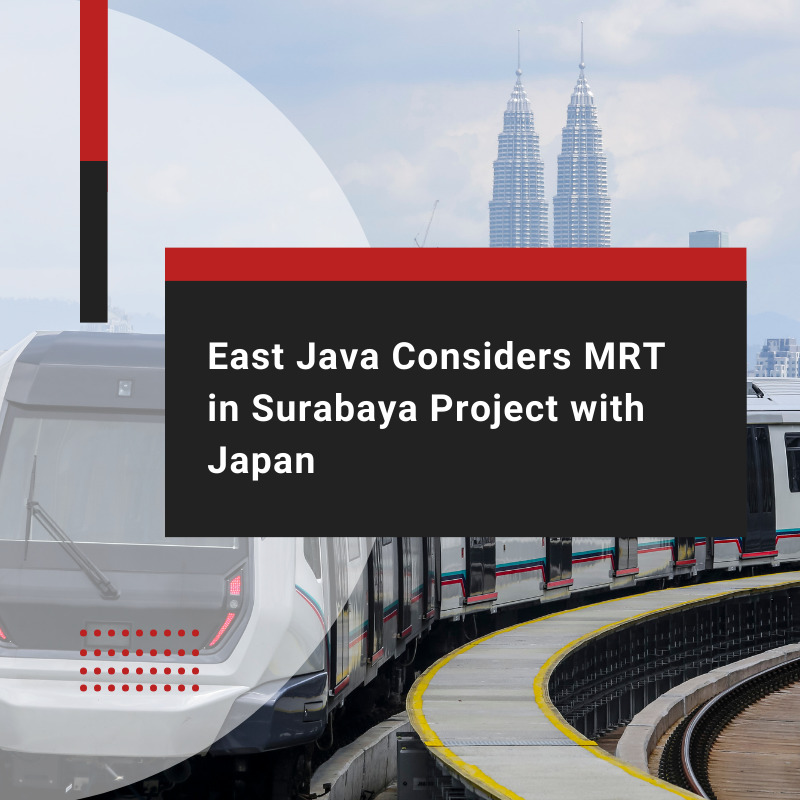The development of Mass Rapid Transit (MRT) has become a focal point for many cities worldwide. Surabaya, Indonesia’s second-largest city, is no exception. This article delves into the significance of the MRT in Surabaya and its potential to bolster the city’s economy and infrastructure.
East Java’s Exploration of an MRT Project in Surabaya
Surabaya has been identified as one of the priority areas for the Sustainable Urban Mobility Plan (SUMP) in the Gerbangkertosusila region (Gresik – Bangkalan – Mojokerto – Surabaya – Sidoarjo – Lamongan), which the East Java Provincial Government is developing with the assistance of Bappenas.
As a result, the government is constructing an MRT in Surabaya. This development addresses the need for mass transportation to meet the high demand in the densely populated Surabaya Metropolitan area. The MRT feasibility study will run from January to December 2024.
Collaboration with Japan
Deputy Governor of East Java Emil Dardak stated that the MRT project in Surabaya is feasible based on a study conducted by the Japan International Cooperation Agency (JICA).
Like the Jakarta MRT project, the Surabaya MRT project will involve JICA in its construction. Since 2019, Japan has consistently been the top export destination for goods from East Java.
Although it briefly slipped to second place in 2022, it reclaimed its position as the leading destination for East Java’s exports in 2023. In 2023, the trade balance between East Java and Japan showed a surplus of US$ 1.39 billion for East Java.
Historical Japan-Indonesia Partnership in East Java
Japan’s collaboration and investment in constructing the MRT in Surabaya is not their first endeavor. Japan has been investing in East Java since 2010-2023. Twenty-three sectors distributed across 15 districts/cities in East Java have a total investment value of USD 4,760.37 million.
The most significant investments are in the primary metal industry sectors, non-machinery metal products, and equipment.
The East Java Provincial Government intends to study disaster management, especially regarding disaster preparedness in Tokyo and Osaka.
Potential Benefits of the MRT Project for East Java

The introduction of MRT in Surabaya marks a significant milestone in infrastructure development. With seamless connectivity across key areas, MRT facilitates the movement of people and goods, thereby stimulating economic growth.
Surabaya’s MRT system is poised to enhance productivity, attract investment, and propel the city towards sustainable development. Here are the advantages of MRT development:
1. Enhanced Convenience
Surabaya and its surrounding areas are congested with commuters every day. As a new mass transportation system in East Java, the MRT is expected to provide a convenient mode of transportation for the public. This will make it easier for people to switch from using their private vehicles to the MRT.
For instance, if someone travels by car from Mojokerto Station to Tanjung Plaza, it may take 1 to 2 hours, but using the MRT will only take 30 minutes, significantly reducing travel time.
2. Job Creation
The construction of the MRT in Surabaya can also generate employment opportunities. Regarding the Jakarta MRT construction, approximately 40,000 jobs were created during the construction period. This opens up many opportunities for job seekers, both during and after the project.
3. Area Development
As a new infrastructure in East Java, the MRT will naturally attract visitors from outside the region who may want to experience the MRT or explore the area. This will positively impact East Java, both economically and in terms of reputation.
4. Reduction of Pollution
One of the significant contributors to pollution is exhaust fumes from motor vehicles. With the introduction of the MRT, people will have an alternative to using private vehicles, leading to a decrease in air pollution.
5. Improvement in Community Mobility
The MRT, designed as a public transportation mode, is a valuable investment for Indonesia. A well-functioning public transportation system will automatically support community mobility.
Potential Challenges and Mitigation Strategies
While the MRT project holds the promise of numerous benefits, there are still several challenges to address:
1. Public Adaptation
The MRT project poses multifaceted challenges. The fundamental challenge lies with the public as users. Will they adapt quickly, particularly in transitioning from private vehicles to public transportation? Subsidizing transportation fares could encourage this shift.
2. Mass Transport Integration
Another challenge is integrating with existing transportation systems in Surabaya. The MRT needs to connect seamlessly with other modes of transportation already in place. Failure to do so may lead people to continue relying on private vehicles, which they perceive as more convenient.
3. Urban Spatial Adjustment
Furthermore, the construction of MRT infrastructure must consider the existing urban spatial layout. Surabaya is home to many heritage areas with historical significance, which must be carefully considered.
Guide to Doing Business in Batam & Surabaya

Explore Business Opportunities in East Java with InCorp
The establishment of MRT in East Java is expected to stimulate business investment in the region, particularly with Japan’s involvement in the project.
InCorp Indonesia offers comprehensive services, including company registration and investor KITAS assistance for those interested in exploring or establishing a company in East Java.
Our experienced professionals are adept at navigating the complex regulatory framework, allowing you to concentrate on fostering business expansion.
Teddy Willy
Branch Manager - Surabaya Office at InCorp Indonesia
With 10 years of experience in business consultancy, Teddy Willy offers expertise in financial and production auditing, sales and marketing, channels and distribution, supply chain management, and human resources for every business sector in Indonesia.


